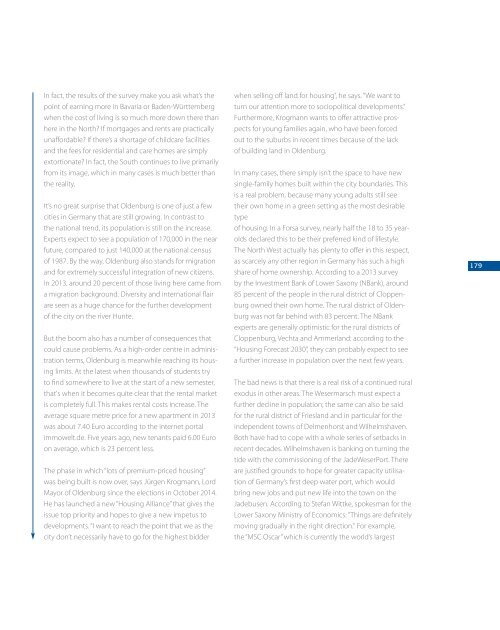Wirtschaftsstandort Oldenburg
You also want an ePaper? Increase the reach of your titles
YUMPU automatically turns print PDFs into web optimized ePapers that Google loves.
In fact, the results of the survey make you ask what’s the<br />
point of earning more in Bavaria or Baden-Württemberg<br />
when the cost of living is so much more down there than<br />
here in the North? If mortgages and rents are practically<br />
unaffordable? If there’s a shortage of childcare facilities<br />
and the fees for residential and care homes are simply<br />
extortionate? In fact, the South continues to live primarily<br />
from its image, which in many cases is much better than<br />
the reality.<br />
It’s no great surprise that <strong>Oldenburg</strong> is one of just a few<br />
cities in Germany that are still growing. In contrast to<br />
the national trend, its population is still on the increase.<br />
Experts expect to see a population of 170,000 in the near<br />
future, compared to just 140,000 at the national census<br />
of 1987. By the way, <strong>Oldenburg</strong> also stands for migration<br />
and for extremely successful integration of new citizens.<br />
In 2013, around 20 percent of those living here came from<br />
a migration background. Diversity and international flair<br />
are seen as a huge chance for the further development<br />
of the city on the river Hunte.<br />
But the boom also has a number of consequences that<br />
could cause problems. As a high-order centre in administration<br />
terms, <strong>Oldenburg</strong> is meanwhile reaching its housing<br />
limits. At the latest when thousands of students try<br />
to find somewhere to live at the start of a new semester,<br />
that's when it becomes quite clear that the rental market<br />
is completely full. This makes rental costs increase. The<br />
average square metre price for a new apartment in 2013<br />
was about 7.40 Euro according to the internet portal<br />
immowelt.de. Five years ago, new tenants paid 6.00 Euro<br />
on average, which is 23 percent less.<br />
The phase in which “lots of premium-priced housing”<br />
was being built is now over, says Jürgen Krogmann, Lord<br />
Mayor of <strong>Oldenburg</strong> since the elections in October 2014.<br />
He has launched a new “Housing Alliance” that gives the<br />
issue top priority and hopes to give a new impetus to<br />
developments. “I want to reach the point that we as the<br />
city don’t necessarily have to go for the highest bidder<br />
when selling off land for housing”, he says. “We want to<br />
turn our attention more to sociopolitical developments.“<br />
Furthermore, Krogmann wants to offer attractive pros -<br />
pects for young families again, who have been forced<br />
out to the suburbs in recent times because of the lack<br />
of building land in <strong>Oldenburg</strong>.<br />
In many cases, there simply isn’t the space to have new<br />
single-family homes built within the city boundaries. This<br />
is a real problem, because many young adults still see<br />
their own home in a green setting as the most desirable<br />
type<br />
of housing. In a Forsa survey, nearly half the 18 to 35 yearolds<br />
declared this to be their preferred kind of lifestyle.<br />
The North West actually has plenty to offer in this respect,<br />
as scarcely any other region in Germany has such a high<br />
share of home ownership. According to a 2013 survey<br />
by the Investment Bank of Lower Saxony (NBank), around<br />
85 percent of the people in the rural district of Cloppenburg<br />
owned their own home. The rural district of <strong>Oldenburg</strong><br />
was not far behind with 83 percent. The NBank<br />
experts are generally optimistic for the rural districts of<br />
Cloppenburg, Vechta and Ammerland: according to the<br />
“Housing Forecast 2030”, they can probably expect to see<br />
a further increase in population over the next few years.<br />
The bad news is that there is a real risk of a continued rural<br />
exodus in other areas. The Wesermarsch must expect a<br />
further decline in population; the same can also be said<br />
for the rural district of Friesland and in particular for the<br />
independent towns of Delmenhorst and Wilhelmshaven.<br />
Both have had to cope with a whole series of setbacks in<br />
recent decades. Wilhelmshaven is banking on turning the<br />
tide with the commissioning of the JadeWeserPort. There<br />
are justified grounds to hope for greater capacity utilisation<br />
of Germany’s first deep water port, which would<br />
bring new jobs and put new life into the town on the<br />
Jadebusen. According to Stefan Wittke, spokesman for the<br />
Lower Saxony Ministry of Economics: “Things are definitely<br />
moving gradually in the right direction.“ For example,<br />
the “MSC Oscar” which is currently the world’s largest<br />
179


















